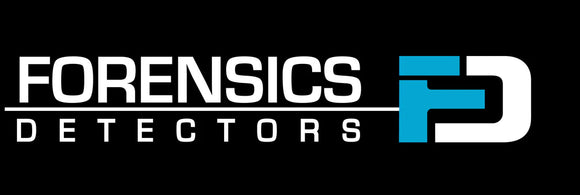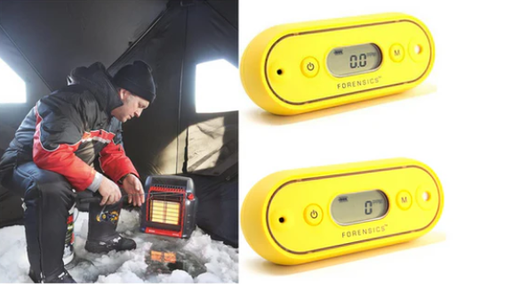Carbon monoxide detectors are essential tools for ensuring the safety of ice fishermen in their tents, shacks, or ice houses. These devices are designed to measure the concentration of carbon monoxide (CO) in the air, which can accumulate to dangerous levels when propane or butane-burning heaters and cooking appliances are used in confined spaces. CO is a colorless, odorless, and tasteless gas that can cause severe health issues, including headaches, dizziness, nausea, and even death if left undetected. Many carbon monoxide detectors not only measure the CO levels but also sound an alarm when a certain threshold is reached, alerting ice fishermen to the danger and prompting them to take immediate action, such as ventilating the area or shutting off the source of the gas. By using carbon monoxide detectors, ice fishermen can protect themselves from the silent killer and enjoy their favorite winter activity with peace of mind.
Pros |
Cons |
|
✅ Carbon monoxide detectors prevent dangers when ice fishing in tents from CO emissions generated from heaters and cookers. ✅ CO emissions from heaters and cookers is a real danger. ✅ Carbon monoxide detectors use a loud sound to notify ice fishermen of unsafe levels of carbon monoxide. |
⛔ Carbon monoxide detectors are not as sensitive at cold temperature (ice fishing) compared to normal room temperatures. ⛔ CO detectors for ice fishing require early low level alarming and a robust design to handle the challenging ice fishing in tents, shacks or ice house. ⛔ Be safe when ice fishing in a tent, get yourself a CO detector. |
What is the Best Carbon Monoxide Detector for Ice Fishing?
In selecting a CO detector for ice fishing, ensure the unit alarms at a low level of Carbon Monoxide that is 50ppm and below. We do not recommend using a home CO detector because they alarm too high and too slow. They alarm at 70ppm at 60 to 240 minutes. For such a small confined space that a ice fishing tent or shack is, a fast and responsive carbon monoxide detector is warranted.
For ice fishing, some excellent carbon monoxide detectors include the following:
- Forensics Detectors Waterproof Low Level CO Detector
- Forensics Detectors Carbon Monoxide Detector Waterproof
- Sensorcon Waterproof Carbon Monoxide Detector (check temp range)
- Klein Tools CO Meter (check temp range)
- Extech Carbon Monoxide Meter (check temp range)
What is Ice Fishing?
Ice fishing describes the recreational activity where people seek to catch fish using a line and hook, or a more elaborate fishing rod, through an open hole in the ice coating a body of water. Often, ice houses, fishing tents or shacks are used in order for individuals to stay warm while fishing.

Is Ice Fishing Dangerous?
Ice fishing can be dangerous if proper precautions are not taken. This is especially true for individuals who are new to ice fishing and may not have done an adequate amount of research first.
Most obviously, falling through the ice into the cold water below is one of the largest dangers of ice fishing. This can cause hypothermia and frostbite among other conditions and injuries.
Another danger associated with ice fishing involves the heaters that anglers frequently bring with them to stave off the cold. These have the potential to cause fire, burns, and carbon monoxide poisoning.
Finally, as with all activities, anglers should be aware of potential dehydration that they may be experiencing and respond accordingly.
What is Carbon Monoxide?
Carbon monoxide is a gaseous compound made up of one part carbon and one part oxygen. According to the CDC, it is an odorless and colorless gas that has the capacity to kill people.
Why is Carbon Monoxide a Problem During Ice Fishing?
Carbon monoxide becomes a problem while ice fishing due to the use of heaters to stay warm in the outdoor activity. If used incorrectly, they may potentially expose the user to harmful levels of carbon monoxide and potentially cause carbon monoxide poisoning.
The Michigan Department of Community Health advises users to not use a grill in the heater's presence and to not use a heater in the shelter if there is not proper ventilation.
Do Fish House Heaters Emit Carbon Monoxide?
Fish house heaters, can emit carbon monoxide which is why they can be dangerous if they are not used properly and carbon monoxide is not monitored properly. Improper ventilation is the biggest cause of improper use and danger.
This is counter to the objective of heating the ice house. For example, one would want to reduce external air from entering the ice house, fish house, fish tent or ice shack in order to increase heating efficiency and preserve heat in the tent. Doing so starves the space of fresh air limiting the heater air supply to the combustion which increases carbon monoxide emissions and elevates carbon monoxide accumulation within the tent. In other words, a deadly cycle occurs.
So, the only way to stay safe is to have an appropriate CO detector and ensure adequate ventilation in your tent, ice house or shack.
Sunflower Style Heaters
Popular heaters used during ice fishing in tents include the Sunflower Style Heaters. These radiate heat from the "sunflower" elements that combust propane gas.

Buddy Heaters
The Buddy Heater is also a very portable heater running on propane gas. If ventilation is limited, that can produce large amounts of carbon monoxide gas.

Typical Warning in User Manual
Carbon Monoxide warnings on these heaters are serious. The Buddy Heaters User Manual states the following:
WARNING: CARBON MONOXIDE POISONING MAY CAUSE DEATH OR INJURYWhen used without adequate combustion and ventilation air, heater may give off excessive CARBON MONOXIDE, an odorless, poisonous gas. This is an unvented gas fired heater. The heater uses air (oxygen) from the area in which the heater is used. Adequate combustion and ventilation air must be provided. |
Where Should I Place the Carbon Monoxide Detector During Ice Fishing?
- While ice fishing, be sure to place the carbon monoxide detector within the ice house. This way, it can detect dangerous levels of carbon monoxide due to the gases released from the heater inside of the ice house.
- Keep it away from door or ventilation openings. Keep it as close to your man as possible (to represent the air / carbon monoxide you are inhaling).
- Keep it off the ice.
- Clip it to your jacket or on your bag.
- Ensure it is placed in a location you can always see it and hear it.

Have There Been Deaths From Carbon Monoxide While Ice Fishing?
Yes there have been. Some examples include the following:
- In 2017, a woman in Minnesota was found dead and four others were hospitalized as a result of the poisoning.
- In 2016, a father of two was killed by carbon monoxide poisoning.
- In 2021, a man and a woman in Winnipeg passed away as a result of carbon monoxide poisoning in their ice fishing shacks.
Why is a Standard Home CO Detector Not Suitable for Ice Fishing?
Regular carbon monoxide detectors go off once a total of 70 ppm has been recorded for 60 minutes. For such a confined and compromising situation, this is too slow and too high of an alarm level. Hence, UL2034 and similar CO home alarms are actually "dangerous" when used in a ice fishing situation.
More appropriate are, low level carbon monoxide detectors that can detect carbon monoxide concentrations. Regular carbon monoxide detectors go off once a total of 70 ppm has been recorded for 60 minutes while low level carbon monoxide detectors go off at 10ppm or 25ppm depending on the model.
How Long Does it Take to Show Signs of Carbon Monoxide Poisoning?
Showing signs of carbon monoxide poisoning can take as little as 5 or less minutes depending on the level of exposure to the carbon monoxide and the concentration of carbon monoxide present. High carbon monoxide concentrations can potentially kill individuals in 5 minutes while lower levels of exposure may take 2 hours or longer for individuals to start having symptoms. Such symptoms may include the following:
- Headache
- Dizziness
- Confusion
- Stomach pain
- Shortness of breath
- Difficulty breathing
- Difficulty thinking
- Vertigo
- Loss of physical co-ordination
- Loss of consciousness
What Does Carbon Monoxide Smell Like?
Carbon monoxide is an odorless gas, meaning that it cannot be smelled.
Can You Smell Carbon Monoxide While Ice Fishing?
No, carbon monoxide is completely odorless and invisible. You need a proper CO detector in your ice fishing shelter to detect this potentially lethal gas.
Carbon Monoxide (CO) vs. Carbon Dioxide (CO2)
Be careful and not to mix up CO for CO2. CO is carbon monoxide, the dangerou gas when ice fishing. CO2 is not immediately dangerous and is the gas humans exhale.
-
Dangers of CO in Propane Heaters: Using propane heaters in enclosed spaces like shacks or tents primarily poses a risk of carbon monoxide poisoning, which can be lethal.
-
Misconception about CO2: There's a common misunderstanding where people refer to carbon monoxide as CO2, but CO2 is not the primary gas of concern in these situations.
-
Importance of Correct Detectors: CO detectors are essential for safety in spaces where propane heaters are used, as they alert to the presence of carbon monoxide.
-
Ineffectiveness of CO2 Detectors for CO: CO2 detectors will not alert to carbon monoxide presence, so they're not suitable for detecting the gas that poses the most significant risk with propane heaters.
-
Awareness and Safety Measures: The post emphasizes the importance of public awareness and correct use of gas detectors to prevent carbon monoxide poisoning in enclosed spaces.
Final Words
Carbon monoxide (CO) is a silent and deadly threat to ice fishermen who use tents, houses, or shacks. This odorless, colorless, and tasteless gas can quickly accumulate to lethal levels in confined spaces, especially when propane heaters or cookers are used for warmth and cooking. To prevent carbon monoxide poisoning, it is crucial for ice fishermen to take proper precautions, including ensuring adequate ventilation in their shelters. Due to the small size of ice fishing tents and the potential for high CO emissions from propane-powered appliances, it is strongly recommended that ice fishermen use a low-level, fast-reacting carbon monoxide detector. These detectors can quickly identify dangerous CO concentrations and alert occupants before the gas reaches life-threatening levels. By prioritizing ventilation and utilizing sensitive CO detectors, ice fishermen can protect themselves from the invisible danger of carbon monoxide and safely enjoy their time on the ice.
About The AuthorDr. Kos Galatsis ("Dr.Koz") is the President of FORENSICS DETECTORS, where the company operates from the scenic Palos Verdes Peninsula in Los Angeles, California. He is a subject matter expert on gas sensor technology, gas detectors, gas meters, and gas analyzers. He has been designing, building, manufacturing and testing toxic gas detection systems for over 20 years. 
Every day is a blessing for Dr. Koz. He loves to help customers solve their unique problems. Dr. Koz also loves spending time with his wife and his three children going to the beach, grilling burgers, and enjoying the outdoors. Read more about Forensics Detectors here. Email: drkoz@forensicsdetectors.com |

